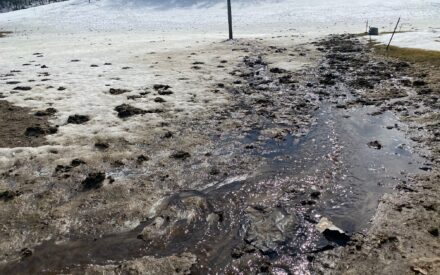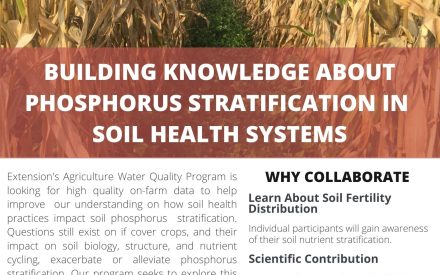As the quantity and quality of on-farm data increase over time, the understanding of how agriculture impacts water quality has evolved. As research and monitoring technology has progressed, the scientific community is looking at more than runoff and soil loss, but rather, different forms of phosphorus (P). In the past, total P was discussed, but now is broken down into particulate P and dissolved P. This quantification and distinction complicates the story (Figure 1) but also helps to distinguish the concepts of the amount of surface runoff compared to soil loss.
May June and July are critical for soil loss
Twenty years of Discovery Farms research has shown that soil loss and surface runoff don’t necessarily peak during the same months. A majority of soil loss occurs during May and June in Wisconsin (Figure 2). This is when P is lost in the particulate form. Particulate P is bound to soil particles and thus is lost with soil movement. Reduced tillage and cover crops help to keep soil in place by promoting soil aggregation and providing residue that protects soil from wind and water during this vulnerable period. The increase in the adoption of soil conservation practices has started to address the particulate P loss in the critical months of May, June, and July across Wisconsin.
January February and March are critical for dissolved P loss
Dissolved P is the portion of P in solution with water and does not need soil movement to be lost. The majority of these losses occur in January, February, and March, during periods of frozen soil and/or snowmelt (Figure 3). Clear runoff does not always mean that no P is leaving the field.
When water interacts with organic and water-soluble forms of P, dissolved P can enter runoff. Commonly, one may think of recent manure applications as the source for dissolved P. But it can come from water interacting with any P sources such as fall surface applied fertilizer, residue from the last crop or cover crop, or P in the soil. Dissolved P is commonly lost in systems where P is not incorporated and becomes concentrated at the surface, like no-till or generally where nutrients are surface applied. Since the ground is frozen in the winter, during precipitation events or snow melt, water infiltration is limited or prevented causing dissolved P to leave via runoff.
Reduce Surface P
One practical solution is to decrease these sources of P, especially those concentrated at the surface where it can interact with runoff. Soil test phosphorus (STP) can remain high in fields where additions of P are greater than crop removal. This can occur when manure nutrient content differs from estimated average values, and when expected crop yields may be unrealistically high. Harvesting cover crops as forage and decreasing the amount of P applied can reduce high STP by slowly correcting historic imbalances.
Spring application of nutrients, closer to when crops uptake nutrients, can remove the risk of loss during snowmelt. But regardless of timing, prioritizing placement below the surface is key to addressing surface soil phosphorus buildup and to protecting nutrients from annual runoff events in the long term. In a strip-till system only narrow strips are tilled and nutrients can be placed 4-8 inches below the surface. By placing nutrients below the surface, they can attach to the soil, and then proven conservation strategies like residue and over-wintering cover crops can protect the soil, and its newly applied fertility.
Research informs solutions
Dissolved P loss is a difficult issue to fix, since the weather can’t be controlled, but the community can work to decrease the amount of P available at the surface. The Extension Ag and Water Quality Program will work with Discovery Farms on new monitoring sites, as well as researchers from Wisconsin and other states to explore mechanisms to reduce dissolved P loss in no-till systems.
After reducing soil erosion, reducing dissolved P loss is the next step in minimizing the impact on water quality and keeping P where plant roots need it. It was only a few years ago when cover crops following grain crops seemed impossible, but look at how far aerial seeding and inter-seeding have come since. This industry can surely use that same innovation and creativity to address dissolved P. As the industry’s understanding evolves, so should management to get closer to the always-moving target of being the foremost stewards of the land.

 Spring impacts of climate change on Wisconsin agriculture
Spring impacts of climate change on Wisconsin agriculture ▶ Watch: Soil health practices impact on phosphorus pools and availability
▶ Watch: Soil health practices impact on phosphorus pools and availability Save money and get cleaner water by correctly utilizing manure
Save money and get cleaner water by correctly utilizing manure Research opportunity: Building knowledge about phosphorus stratification within Wisconsin’s soil health systems
Research opportunity: Building knowledge about phosphorus stratification within Wisconsin’s soil health systems


